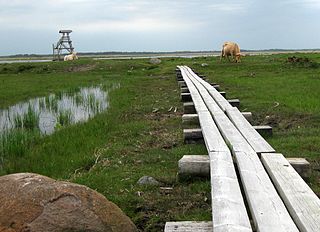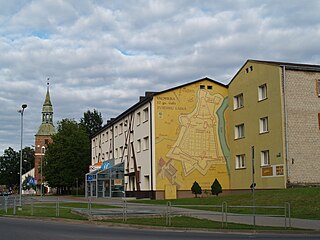Related Research Articles

A transboundary protected area (TBPA) is an ecological protected area that spans boundaries of more than one country or sub-national entity. Such areas are also known as transfrontier conservation areas (TFCAs) or peace parks.

Nigula Nature Reserve is a nature reserve situated in South-West of Estonia, in Häädemeeste and Saarde parishes of Pärnu County. It has an area of 63.98 km². Nigula nature reserve is one of the oldest bog reserves in Estonia. It is established to protect the Nigula Bog and its surrounding forests in their natural state.

Lake Engure is a lake in the western part of Latvia, in the Talsi District. It is the third largest lake in the country after Lake Lubāns and Lake Rāzna.

Lake Engure Nature Park is a protected park in Latvia covering 197.62 km2 (76.30 sq mi), named for Lake Engure. It was designated as a nature spot in 1998.

The North Vidzeme Biosphere Reserve(NVBR) (Latvian: Ziemeļvidzemes biosfēras rezervāts) is the only biosphere reserve in Latvia, located in the northern Vidzeme region in north-western Latvia along the border with Estonia. The reserve includes varied natural and semi-natural habitats in primal and traditional landscapes. NVBR includes 25 nature reserves, one nature park and two marine protected territories.

Protected areas of Poland include the following categories, as defined by the Act on Protection of Nature of 16 April 2004, by the Polish Parliament:

Alam-Pedja Nature Reserve is the largest nature reserve in Estonia. It is a vast wilderness area which covers 342 km2 and consists of a complex of 5 large bogs separated by unregulated rivers, their floodplains, and extensive forests. The nature reserve aims to protect diverse ecosystems and rare species, mainly through preserving the natural development of forests and bogs and securing the continuing management of semi-natural floodplain grasslands.

Endla Nature Reserve is a nature reserve situated in central Estonia.
Sookuninga Nature Reserve is a nature reserve situated in south-western Estonia, in Pärnu County.

Teiči Nature Reserve is a nature reserve situated in eastern Latvia, spread across Madona, Varakļāni and Jēkabpils municipalities.

Kerzhinski Nature Reserve is a Russian 'zapovednik' located in the middle basin of the Kerzhenets River, 600 kilometres (370 mi) east of Moscow. The terrain features extensive upland and lowland swamps, and is known in particular as a site for the study of beavers, and their effects on recovery of the landscape after fires and logging. The reserve is situated 55 km northeast of the City of Nizhny Novgorod in the Bor and Semonov districts of Nizhny Novgorod Oblast. The site has been a center for scientific study of nature of the region since 1933. It is part of a UNESCO Biosphere Reserves, Ramsar wetland. The reserve was established in its current form in 1993, and covers an area of 46,940 ha (181.2 sq mi).

The Cenas tīrelis is a bog located in the municipalities of Mārupe and Olaine, approximately 30 kilometers west of Riga, Latvia. It is a Natura 2000 protected site and one of Latvia's 261 nature reserves. It was formed 5000 years ago.

Dabas parks Piejūra is a nature park along the Gulf of Riga in Latvia founded in 1962. It is a protected nature reserve and a Natura 2000 location. The park stretches 36.6 kilometres (22.7 mi) over an 4,180 hectares area from Riga, through Carnikava Municipality, and up to Saulkrasti. It is a popular seasonal recreation location, notably for beach access. The park is notable for its protected biotopes, particularly its dunes and boreal forests. The park's conservation plan for 2020 onwards was developed under the "LIFE CoHaBit" project.

South Kurzeme Municipality is one of the 35 municipalities established in Latvia in 2021. It surrounds Liepāja, Latvia's third largest city. Its first elected municipal council took office on 1 July 2021. Its seat is at Grobiņa.

Augšdaugava Municipality is one of the 35 municipalities established in Latvia in 2021. It surrounds the independent city of Daugavpils and its municipal headquarters are located there. Its first elected municipal council has taken office on 1 July 2021.

Valmiera Municipality is one of the 35 municipalities established in Latvia in 2021, located approximately 180 kilometres (110 mi) west of the national capital Riga. Its first elected municipal council took office on 1 July 2021. Its seat is the city of Valmiera.

The Torey Lakes are a pair of soda lakes, Barun-Torey and Zun-Torey, in Russia's Zabaykalsky Krai, on the border with Mongolia — the Mongolia–Russia border runs across the southern tip of Zun-Torey lake.

Gaizinkalns Nature Park is can be found in Latvia in Madona Municipality Vestienas, Aronas and Bērzaunes parishes, Natura 2000 territory. The territory of the park covers Vidzeme Uplands around Gaizinkalns, Lake Talejas and Viešūrs, as well as several small lakes. Here is the highest place in Latvia - Gaizinkalns - 311.94 m.
References
- 1 2 Latvia, Europe. UNEP-WCMC (2018). Protected Area Profile for Latvia from the World Database of Protected Areas, November 2018. Protected Planet
- ↑ (in Latvian) Par īpaši aizsargājamām dabas teritorijām Dabas aizsardzības pārvalde, Visas tiesības aizsargātas.
- ↑ Latvia IV. Protected Planet
- ↑ Latvia Ramsar Site. Wetland of International Importance Protected Planet
- ↑ (in Latvian) RAMSAR mitrāji Dabas aizsardzības pārvalde, Visas tiesības aizsargātas.
- ↑ Latvia Protected Landscape Area Protected Planet
